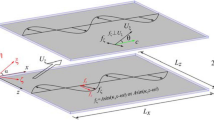Abstract
The impact of transversal spanwise traveling surface waves on the wall-shear stress distribution of high Reynolds number turbulent boundary layer flows is analyzed using high-resolution large-eddy simulations. The Reynolds numbers based on the friction velocity are R e t = 540, 906, 1908, and 2250. The surface wave motion defined by the amplitude, the wavelength, and the phase speed in inner coordinates is constant for the investigated R e t range. When the Reynolds number is increased, the drag reduction decreases from 11 % to 1 %. That is, in contrast to the result in the literature for actuated channel flow, which shows the drag reduction (DR) as a function of the Reynolds number based on the friction velocity to be proportional to \(Re_{\tau }^{-0.2}\) for R e t = 1000, the current analysis for evolving turbulent boundary layers over actuated surfaces leads to DR\(\sim Re_{\tau }^{-1}\). The detailed analysis of the velocity profiles in the viscous sublayer clearly shows that the major difference in the velocity gradient occurs above the trough where the velocity gradient is reduced by increasing Reynolds number. At low Reynolds numbers, the peak value of the wall-normal vorticity distribution above the moving wave crest and above the moving wave trough is much smaller than that of the non-actuated wall resulting in a pronounced drag reduction. At increasing Reynolds number, the difference in the wall-normal vorticity distribution in the near-wall region for the actuated and the non-actuated wall becomes smaller leading to a lower drag reduction. The analysis of the anisotropy map shows that the wall actuation excites the two-component turbulence in the viscous sublayer above the crest and the trough. That is, unlike passively controlled flow, the drag reducing mechanism is related not to the one-component but to the two-component state in the anisotropy map.
Similar content being viewed by others
References
Karniadakis, G., Choi, K.S.: Ann. Rev. Fluid Mech. 35(1), 45 (2003) http://www.annualreviews.org/doi/abs/10.1146/annurev.fluid.35.101101.161213
Quadrio, M.: Phil. Trans. R. Soc. A 369(1940), 1428 (2011) http: //rsta.royalsocietypublishing.org/content/369/1940/1428.short
Jung, W., Mangiavacchi, N., Akhavan, R.: Phys. Fluids 4(8), 1605 (1992) http://scitation.aip.org/content/aip/journal/pofa/4/8/10.1063/1.858381
Akhavan, R., Jung, W., Mangiavacchi, N.: Advances in turbulence IV, pp 299–303. Springer (1993). http://link.springer.com/chapter/10.1007/978-94-011-1689-3_48
Quadrio, M., Ricco, P.: J. Fluid Mech. 521, 251 (2004) http://journals.cambridge.org/abstract_S0022112004001855
Touber, E., Leschziner, M.A.: J. Fluid Mech. 693, 150 (2012) http://journals.cambridge.org/abstract_S0022112011005076
Agostini, L., Touber, E., Leschziner, M.: J. Fluid Mech. 743, 606 (2014) http://journals.cambridge.org/abstract_S0022112014000408
Du, Y., Symeonidis, V., Karniadakis, G.: J. Fluid Mech. 457, 1 (2002) http://journals.cambridge.org/abstract_S0022112001007613
Zhao, H., Wu, J.Z., Luo, J.S.: Fluid Dyn. Res. 34(3), 175 (2004) http://www.sciencedirect.com/science/article/pii/S0169598303001412
Itoh, M., Tamano, S., Yokota, K., Taniguchi, S.: J. Turbul. 7 (2006). http://www.tandfonline.com/doi/abs/10.1080/14685240600647064
Tamano, S., Itoh, M.: J. Turbul. 13 (2012) http://www.tandfonline.com/doi/abs/10.1080/14685248.2012.655743
Bai, H., Zhou, Y., Zhang, W., Xu, S., Wang, Y., Antonia, R.: J. Fluid Mech. 750, 316 (2014) http://journals.cambridge.org/article_S0022112014002614
Klumpp, S., Meinke, M., Schröder, W.: J. Turbul. 11 (2010) http://www.tandfonline.com/doi/abs/10.1080/14685248.2010.494606
Klumpp, S., Meinke, M., Schröder, W.: Flow Turbul. Combust. 87(1), 33 (2011) http://link.springer.com/article/10.1007/s10494-011-9326-3
Boris, J., Grinstein, F., Oran, E., Kolbe, R.: Fluid Dyn. Res. 10(4–6), 199 (1992) http://iopscience.iop.org/1873-7005/10/4-6/A01
Meinke, M., Schröder, W., Krause, E., Rister, T.: Comput. Fluids 31 (4), 695 (2002) http://www.sciencedirect.com/science/article/pii/S0045793001000731
Alkishriwi, N., Meinke, M., Schröder, W. Comput. Fluids 35(10), 1126 (2006) http://www.sciencedirect.com/science/article/pii/S0045793005000848
Renze, P., Meinke, M., Schröder, W.: Conference on Turbulence and Interactions TI2006, Porquerolles, France (2006)
Rütten, F., Schröder, W., Meinke, M.: Phys. Fluids 17(3), 035107 (2005) http://scitation.aip.org/content/aip/journal/pof2/17/3/10.1063/1.1852573
Klumpp, S., Meinke, M., Schröder, W.: Flow, Turbul. Combust. 85(1), 57 (2010) http://link.springer.com/article/10.1007/s10494-010-9251-x
Renze, P., Schröder, W., Meinke, M.: Int. J. Heat Fluid Flow 29(1), 18 (2008) http://www.sciencedirect.com/science/article/pii/S0142727X07001129
Roidl, B., Meinke, M., Schröder, W.: Int. J. Heat Fluid Flow 44, 28 (2013) http://www.sciencedirect.com/science/article/pii/S0142727X13000787
Jarrin, N., Benhamadouche, S., Laurence, D., Prosser, R.: Int. J. Heat Fluid Flow 27(4), 585 (2006) http://www.sciencedirect.com/science/article/pii/ S0142727X06000282
Fares, E., Schröder, W.: Flow, Turbul. Combust. 73(3–4), 187 (2005) http://link.springer.com/article/10.1007/s10494-005-8625-y
Roidl, B., Meinke, M., Schröder, W.: Int. J. Heat Fluid Flow 45, 1 (2014) http://www.sciencedirect.com/science/article/pii/S0142727X13002154
Koh, S.R., Meinke, M., Schröder, W.: AIAA Paper 2012-2183, 18th AIAA/CEAS Aeroacoustics Conference, 4–6 June 2012, Colorado Springs (2012)
Lumley, J.L., Newman, G.R.: J. Fluid Mech. 82, 161 (1977) http://journals.cambridge.org/abstract_S0022112004001855
Frohnapfel, B., Lammers, P., Jovanovic, J., Durst, F.: J. Fluid Mech. 577, 457 (2007) http://journals.cambridge.org/abstract_S0022112004001855
Fernholz, H.H., Finley, P.J.: Prog. Aerosp. Sci. 32(4), 245 (1996) http://www.sciencedirect.com/science/article/pii/0376042195000070
Choi, K.S., Xu, C.X., Sung, H.J.: AIAA J. 40(5), 842 (2002) http://arc.aiaa.org/doi/pdf/10.2514/2.1750
Roggenkamp, D., Jessen, W., Li, W., Klaas, M., Schröder, W.: (2014). Manuscript submitted for publication
Author information
Authors and Affiliations
Corresponding author
Rights and permissions
About this article
Cite this article
Koh, S., Meysonnat, P., Meinke, M. et al. Drag Reduction Via Spanwise Transversal Surface Waves at High Reynolds Numbers. Flow Turbulence Combust 95, 169–190 (2015). https://doi.org/10.1007/s10494-015-9614-4
Received:
Accepted:
Published:
Issue Date:
DOI: https://doi.org/10.1007/s10494-015-9614-4




